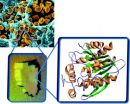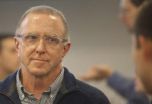(Press-News.org) WASHINGTON D.C. Feb. 16, 2014 -- Tularemia, aka "rabbit fever," is endemic in the northeastern United States, and is considered to be a significant risk to biosecurity -- much like anthrax or smallpox -- because it has already been weaponized in various regions of the world.
At the 58th Annual Biophysical Society Meeting, which takes place Feb. 15-19, 2014, in San Francisco, Calif., Geoffrey K. Feld, a Postdoctoral researcher in the Physical & Life Sciences Directorate at Lawrence Livermore National Laboratory (LLNL), will describe his work to uncover the secrets of the bacterium Francisella tularensis, which causes tularemia.
"Despite its importance for both public health and biodefense, F. tularensis pathogenesis isn't entirely understood, nor do we fully understand how the organism persists in the environment," explained Feld.
Previous efforts, funded by both the National Institutes of Health and LLNL, demonstrated that amoebae may serve as a potential reservoir for the bacteria in nature. "Specifically, we demonstrated that amoebae exposed to fully virulent F. tularensis rapidly form cysts -- dormant, metabolically inactive cells -- that allow the amoebae to survive unfavorable conditions," said Amy Rasley, the research team leader.
This encystment phenotype was rapidly induced by F. tularensis in the laboratory and was required for the long-term survival of the bacteria. Further exploration led to the identification of secreted F. tularensis proteins, which are responsible for induction of the rapid encystment phenotype (REP) observed in amoebae.
In the new work, Feld and colleagues characterized two of these REP proteins -- called REP24 and REP34 -- and began to describe their functions based on their three-dimensional crystal structures.
A big surprise finding was that these proteins resembled "proteases," which are proteins that cut other proteins in a specific manner. "Our preliminary data indicate that F. tularensis bacteria lacking these proteins are diminished in their ability to infect or survive in human immune cells, which indicates that these proteins may also contribute to F. tularensis virulence," Feld said.
Rasley and colleagues believe that careful characterization of these two novel F. tularensis proteins may shed light on how this organism persists in the environment and causes disease.
"Ultimately, this type of research could inform efforts to combat the disease, although there is much work to do. Currently, we don't know the protein targets in the host -- amoeba, human, etc. -- that the REP proteins act on, nor do we know the mechanism by which the proteins could help F. tularensis survive in the environment or cause disease," Feld said.
"Once these questions are elucidated, a broader understanding of environmental persistence and pathogenesis might lead to better diagnostics and/or novel countermeasures to combat tularemia," he added.
INFORMATION:
The presentation "Structure and Function of Two Putative Virulence Factors from Francisella tularensis" by Geoffrey K. Feld will be at 1:45 p.m. on Sunday, February 16, 2014 in Hall D in San Francisco's Moscone Convention Center.
ABSTRACT: http://tinyurl.com/n28b6bf
More information about Tularemia from the CDC: http://www.cdc.gov/tularemia/
ABOUT THE MEETING
Each year, the Biophysical Society Annual Meeting brings together more than 7,000 researchers working in the multidisciplinary fields representing biophysics. With more than 4,200 poster presentations, over 200 exhibits, and more than 20 symposia, the BPS Annual Meeting is the largest meeting of biophysicists in the world. Despite its size, the meeting retains its small-meeting flavor through its subgroup symposia, platform sessions, social activities, and committee programs.
The 58th Annual Meeting will be held at the Moscone Convention Center, 747 Howard Street, San Francisco, California.
PRESS REGISTRATION
The Biophysical Society invites professional journalists, freelance science writers and public information officers to attend its Annual Meeting free of charge. For press registration, contact Alisha Yocum at ayocum@biophysics.org or Jason Bardi at 240-535-4954.
QUICK LINKS
Main Meeting Page: http://tinyurl.com/mfjh37p
Program Highlights: http://tinyurl.com/mosxrof
Abstracts Search: http://tinyurl.com/lbrearu
ABOUT THE SOCIETY
The Biophysical Society, founded in 1958, is a professional, scientific Society established to encourage development and dissemination of knowledge in biophysics. The Society promotes growth in this expanding field through its annual meeting, monthly journal, and committee and outreach activities. Its 9000 members are located throughout the U.S. and the world, where they teach and conduct research in colleges, universities, laboratories, government agencies, and industry. For more information on the Society, or the 2014 Annual Meeting, visit http://www.biophysics.org
Uncovering the secrets of tularemia, the 'rabbit fever'
Researchers at Lawrence Livermore National Laboratory solve structures that shed light on how the bacteria may persist in the environment and cause disease
2014-02-17
ELSE PRESS RELEASES FROM THIS DATE:
Bacterial superbug protein structure solved
2014-02-17
WASHINGTON D.C. Feb. 16, 2014 -- A research team from Vanderbilt University Medical Center in Nashville, Tenn., is the first to decipher the 3-D structure of a protein that confers antibiotic resistance from one of the most worrisome disease agents: a strain of bacteria called methicillin-resistant Staphylococcus aureus (MRSA), which can cause skin and other infections. The Vanderbilt team's findings may be an important step in combatting the MRSA public health threat over the next 5 to 10 years.
By deciphering the shape of a key S. aureus protein -- an enzyme called ...
Harvesting light, the single-molecule way
2014-02-17
WASHINGTON D.C. Feb. 16, 2014 -- New insights into one of the molecular mechanisms behind light harvesting, the process that enables photosynthetic organisms to thrive, even as weather conditions change from full sunlight to deep cloud cover, will be presented at the 58th Annual Biophysical Society Meeting, taking place in San Francisco from Feb. 15-19.
At the meeting, Hsiang-Yu Yang, a graduate student, and Gabriela Schlau-Cohen, a postdoc in W.E. Moerner's research group at Stanford University, will describe how probing these natural systems at the single molecule level ...
Deep ocean needs policy, stewardship where it never existed
2014-02-17
BEAUFORT, N.C. -- Technological advances have made the extraction of deep sea mineral and precious metal deposits feasible, and the dwindling supply of land-based materials creates compelling economic incentives for deep sea industrialization. But at what cost?
“We’re really in the dark when it comes to the ecology of the deep sea," said Linwood Pendleton, director of the Ocean and Coastal Policy Program at the Nicholas Institute for Environmental Policy Solutions at Duke University. "We know a lot about a few places, but nobody is dealing with the deep sea as a whole, ...
Obesity in Samoa: A global harbinger?
2014-02-17
PROVIDENCE, R.I. [Brown University] — The South Pacific archipelago of Samoa and American Samoa harbors a global health mystery that may seem both remote and extreme but could foretell trends in obesity and related conditions across much of the developing world.
About three-quarters of the U.S. territory's adult population is obese, the highest rate in the world with independent Samoa quickly catching up. Rates of type 2 diabetes top one in five and a recent study found that the elevated obesity rates are present even in newborns.
This pandemic began only a few decades ...
Global perspectives on human biology and health
2014-02-17
CHICAGO --- Three anthropology professors from the Weinberg College of Arts and Sciences at Northwestern University will highlight recent research in biological anthropology Sunday, Feb. 16 at the annual meeting of the American Association for the Advancement of Science (AAAS) in Chicago.
The presentations, part of the symposium "Comparative Advantage: Global Perspectives on Human Biology and Health" will be held from 1:30 to 4:30 p.m. in Crystal Ballroom A at the Hyatt Regency Chicago.
Christopher Kuzawa, professor of anthropology and faculty fellow at the Institute ...
Nanoelectronics key to advances in renewable energy
2014-02-17
TEMPE, Ariz. – Nanoscale technology looks promising as a major contributor to advancements needed to fulfill the potential of emerging sources of clean, renewable energy.
Progress in the comparatively new area of nanoelectronics in particular could be the basis for new manufacturing processes and devices to make renewable energy systems and technologies more efficient and cost-effective.
Stephen Goodnick will focus on what nanoelectronics advances could do to help push the performance of solar energy systems to the next level in his talk at the 2014 annual meeting of ...
Epigenetic regulation required to ensure correct number of chromosomes
2014-02-17
Abnormal number of chromosomes is often associated with cancer development. In a new study published in the journal Nature Structural and Molecular Biology researchers at Karolinska Institutet in Sweden have shown that a subtle epigenetic change plays an important role in the correct segregation of chromosomes.
Normally when a cell divides, the chromosomes are segregated equally to two daughter cells. However, tumour cells frequently have either too few or too many chromosomes, leading to the incorrect expression of a number of genes. When a cell is about to divide, the ...
New eye layer has possible link to glaucoma
2014-02-17
A new layer in the human cornea — discovered by researchers at The University of Nottingham
last year — plays a vital role in the structure of the tissue that controls the flow of fluid
from the eye, research has shown. The findings, published in a paper in the British
Journal of Ophthalmology, could shed new light on glaucoma, a devastating disease caused by
defective drainage of fluid from the eye and the world's second leading cause of blindness.
The latest research shows that the new layer, dubbed Dua's Layer after the academic Professor
Harminder Dua who ...
Researchers hijack cancer migration mechanism to 'move' brain tumors
2014-02-17
One factor that makes glioblastoma cancers so difficult to treat is that malignant cells from the tumors spread throughout the brain by following nerve fibers and blood vessels to invade new locations. Now, researchers have learned to hijack this migratory mechanism, turning it against the cancer by using a film of nanofibers thinner than human hair to lure tumor cells away.
Instead of invading new areas, the migrating cells latch onto the specially-designed nanofibers and follow them to a location – potentially outside the brain – where they can be captured and killed. ...
U of M study finds fertilization destabilizes global grassland ecosystems
2014-02-17
A new study led by University of Minnesota researchers demonstrates that fertilization of natural grasslands -- either intentionally or unintentionally as a side effect of global farming and industry -- is having a destabilizing effect on global grassland ecosystems. Using a network of natural grassland research sites around the world called the Nutrient Network, the study represents the first time such a large experiment has been conducted using naturally occurring sites.
Led by Yann Hautier, a Marie Curie Fellow associated with both the Department of Ecology, Evolution, ...
LAST 30 PRESS RELEASES:
Do our body clocks influence our risk of dementia?
Anthropologists offer new evidence of bipedalism in long-debated fossil discovery
Safer receipt paper from wood
Dosage-sensitive genes suggest no whole-genome duplications in ancestral angiosperm
First ancient human herpesvirus genomes document their deep history with humans
Why Some Bacteria Survive Antibiotics and How to Stop Them - New study reveals that bacteria can survive antibiotic treatment through two fundamentally different “shutdown modes”
UCLA study links scar healing to dangerous placenta condition
CHANGE-seq-BE finds off-target changes in the genome from base editors
The Journal of Nuclear Medicine Ahead-of-Print Tip Sheet: January 2, 2026
Delayed or absent first dose of measles, mumps, and rubella vaccination
Trends in US preterm birth rates by household income and race and ethnicity
Study identifies potential biomarker linked to progression and brain inflammation in multiple sclerosis
Many mothers in Norway do not show up for postnatal check-ups
Researchers want to find out why quick clay is so unstable
Superradiant spins show teamwork at the quantum scale
Cleveland Clinic Research links tumor bacteria to immunotherapy resistance in head and neck cancer
First Editorial of 2026: Resisting AI slop
Joint ground- and space-based observations reveal Saturn-mass rogue planet
Inheritable genetic variant offers protection against blood cancer risk and progression
Pigs settled Pacific islands alongside early human voyagers
A Coral reef’s daily pulse reshapes microbes in surrounding waters
EAST Tokamak experiments exceed plasma density limit, offering new approach to fusion ignition
Groundbreaking discovery reveals Africa’s oldest cremation pyre and complex ritual practices
First breathing ‘lung-on-chip’ developed using genetically identical cells
How people moved pigs across the Pacific
Interaction of climate change and human activity and its impact on plant diversity in Qinghai-Tibet plateau
From addressing uncertainty to national strategy: an interpretation of Professor Lim Siong Guan’s views
Clinical trials on AI language model use in digestive healthcare
Scientists improve robotic visual–inertial trajectory localization accuracy using cross-modal interaction and selection techniques
Correlation between cancer cachexia and immune-related adverse events in HCC
[Press-News.org] Uncovering the secrets of tularemia, the 'rabbit fever'Researchers at Lawrence Livermore National Laboratory solve structures that shed light on how the bacteria may persist in the environment and cause disease




